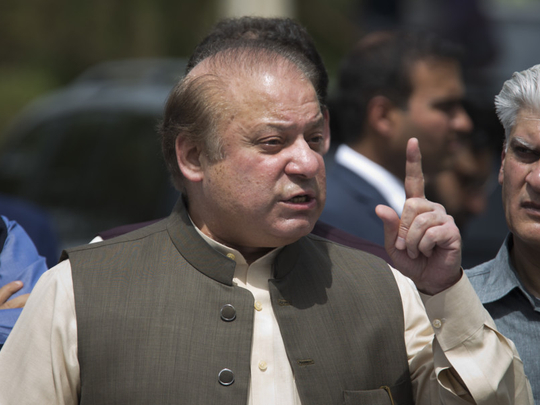
Friday’s announcement of the conclusion of the tenure for Pakistan’s government by May marked a political milestone, though a largely unimpressive one.
Events in the run up to end of the government’s five-year tenure and the increasingly sharp divide among the mainstream political players hardly provide inspiration for the country to embark on a long overdue reform drive.
As Pakistan prepares for a transition that many of its politicians promise will be historical, they are in danger of remaining disconnected with the mainstream.
One of the most significant events remains the dismissal of Prime Minister Shahid Khaqan Abbassi’s predecessor — former prime minister Nawaz Sharif in July 2017.
Offshore wealth
On its own, Sharif’s departure following a supreme court trial for over a year was simply triggered by investigations into the considerable offshore wealth belonging to him and his children.
Yet, the departure of a mainstream politician over questions related to unexplained wealth also triggered deeper questions over the ways of the country’s ruling class and its unwillingness to adhere to laws.
More recently, revelations surrounding politicians and top civil servants have reignited a debate over the primary loyalties of those who rule Pakistan.
Such questions over time have also triggered increasingly troubling concerns over Pakistan’s ability to reform itself.
As ruling politicians from one regime after another have sought to convey the impression that Pakistan’s mainstream all over the country will become increasingly prosperous, the reality has been far different.
The dismal realities surrounding the mainstream are very evident across the network of government-funded educational institutions and/or medical services, where scores of ordinary Pakistanis suffer helplessly every day.
For months, Sharif has campaigned hard from one public appearance to another, seeking to publicise the “miscarriage” of justice that led to his removal.
Multiple challenges
Yet, in his frequent utterances in the name of protecting Pakistan’s democratic values and civilian rule, there has hardly been more than passing references at best to the multiple challenges surrounding the mainstream population.
In one respect, this continuing contrast has mirrored Pakistan’s evolution over the past many years where one government after another has ignored real life challenges.
It’s therefore not surprising that some of the most vociferous critics have regularly pointed towards the country having become an elitist state — meant to serve the needs of individuals with clout, rather than the much wider community.
During Sharif’s tenure as prime minister, which began in 2013, his government repeatedly reminded Pakistanis of the billions of dollars in investments that are destined to arrive under the CPEC or China-Pakistan Economic Corridor.
The corridor represents a number of road and train transportation projects that will eventually link western China to Pakistan’s southern Gwadar port near the Iranian border.
Additionally, the corridor also contains projects for the supply of energy resources to consumers across Pakistan.
But notwithstanding the possibility of a sea change that might eventually arrive for the future of Pakistan, the promise of these investments has done little to allay concerns over poverty that is likely to hit parts of the country.
Tragically, the story of the rich who will directly benefit from CPEC-related projects such as new industries that will consume new energy supplies, could well repeat the skewed development of the past where the relatively few rich become richer.
The story of the disconnect surrounding Pakistan’s rulers of today equally applies historically to trends under the rule of former president Asif Ali Zardari’s Pakistan People’s Party (PPP), which ruled from 2008 till 2013.
During those five years, stories of corruption in top tiers of the ruling structure progressed side by side with rapidly mounting shortages of electricity and gas across the country.
And in spite of frequent promises and deadlines announced by key decision-makers to end electricity shortages, little progress was made.
Similarly, former general Pervez Musharraf, who ruled for nine years from 1999 till 2008, began his tenure with a promise of a long overdue campaign against corruption.
And the 20th anniversary of General Musharraf’s takeover, which falls next year, appears to throw up little hope, and future trends are unlikely to be different from the environment surrounding his military coup.
Intense fight
Going forward, Pakistan will likely see an intensely fought election later this year.
Among the key political competitors, the Pakistan Tehreek-e-Insaaf (PTI) or Pakistan Justice Movement led by Imran Khan, former cricket star-turned-politician, remains the only political force which has previously not ruled the country’s federal government in Islamabad.
Khan’s PTI in the past five years has ruled the northern province known as Khyber Pakhtunkhwa or KPK, while the party has campaigned aggressively against Sharif on allegations of corruption.
Though his message offers a breath of fresh air, it’s unclear if the PTI will be more than a partner in a coalition when the next ruling structure comes to power.
The elections may provide a political transition, but Pakistan continues to wait for a transition that will change the destiny of the country and the population at large.
Farhan Bokhari is a Pakistan-based commentator who writes on political and economic matters.









